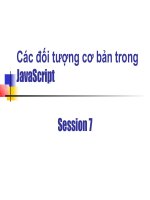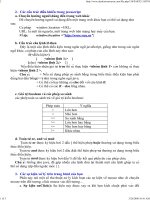Luồng và xử lý file trong Java
Bạn đang xem bản rút gọn của tài liệu. Xem và tải ngay bản đầy đủ của tài liệu tại đây (254.58 KB, 51 trang )
Lập trình Java cơ bản
1
Cao Đức Thông - Trần Minh Tuấn
,
Bài 7. Luồng và xử lý file
2
• Khái niệm luồng
• Các luồng byte
• Đối tượng serializable
• Các luồng ký tự
• File truy cập ngẫu nhiên
• Lớp File
• Bài tập
Khái niệmluồng (stream)
3
• Luồng là một “dòng chảy” của dữ liệu
được gắn với các thiết bị vào ra.
• Hai loại luồng:
• Luồng nhập: Gắn với các thiết bị nhập
như bàn phím, máy scan, file...
• Luồng xuất: Gắn với các thiết bị xuất như
màn hình, máy in, file...
• Việc xử lý vào ra thông qua luồng giúp
cho lập trình viên không phải quan tâm
đến bản chất của thiết bị vào ra.
Khái niệmluồng (stream)
4
• Chương trình đọc trên luồng nhập để lấy dữ
liệu từ thiết bị nhập, ghi vào luồng xuất để
đưa dữ liệu ra thiết bị xuất
Input
Device
Input Stream
Program
Output
Device
Output Stream
Các luồng cơ bản
5
• Luồng byte: Là dòng chảy các byte
• InputStream: Luồng nhập byte cơ bản
• OutputStream: Luồng xuất byte cơ bản
• Luồng ký tự: Là dòng chảy các ký tự
(char)
• Reader: Luồng nhập ký tự cơ bản
• Writer: Luồng xuất ký tự cơ bản
• Các lớp luồng nằm trong gói java.io
Luồng byte
6
ByteArrayInputStream
FileInputStream
FilterInputStream
ObjectInputStream
PipedInputStream
SequenceInputStream
StringBufferInputStream
BufferedInputStream
LineNumberInputStream
PushbackInputStream
DataInputStream
InputStream
Luồng byte
7
ByteArrayOutputStream
FileOutputStream
FilterOutputStream
ObjectOutputStream
PipedOutputStream
DataOutputStream
BufferedOutputStream
OutputStream
PrintStream
Luồng nhập/xuất byte cơ bản
8
• InputStream và OutputStream là hai
lớp gốccủamọiluồng nhập/xuất byte
(abstract).
Object
InputStream OutputStream
Lớp InputStream
9
• Mộtsố phương thứccủa InputStream
• abstract int read() throws IOException
• Đọc một byte từ luồng.
• Nếu cuối luồng sẽ trả về -1
• int read(byte[] b) throws IOException
• Đọc một dãy byte từ luồng
• void close() throws IOException
• Đóng luồng nhập
• int available() throws IOException
• Trả về số byte có thểđọc tiếp
• long skip(long n) throws IOException
• Bỏ qua n byte
LớpOutputStream
10
• Mộtsố phương thứccủa OutputStream
• abstract void write(int b) throws IOException
• Ghi mộtbyte raluồng
• void write(byte[] b) throws IOException
• Ghi một dãy byte ra luồng
• void close() throws IOException
• Đóng luồng
• void flush() throws IOException
• Dồnxuất luồng
Các luồng file
11
• Đượcsử dụng để xuấtnhập vớifile.
• Luồng nhập từ file: FileInputStream
• FileInputStream(String name)
• FileInputStream(File f)
• Luồng xuất ra file: FileOutputStream
• FileOutputStream(String name)
• FileOutputStream(File f)
• FileOutputStream(String name, boolean append)
• Phương thức nhập/xuất của các luồng file
giống như của các luồng nhập xuất cơ bản
Ví dụ: Đọcvàhiểnthị file (v1)
12
import java.io.*;
public class ReadFile
{
public static void main(String[] args)
{
try {
FileInputStream f = new FileInputStream("readme.txt");
int ch;
while ( (ch = f.read()) != -1 )
{
System.out.print((char)ch);
}
f.close();
} catch (FileNotFoundException d) {
System.out.println("File not found");
} catch (IOException d) {
System.out.println("Can not read file");
}
}
}
Ví dụ: Ghi dữ liệu ra file
13
import java.io.*;
public class WriteFile
{
public static void main(String[] args)
{
byte buffer[] = new byte[80];
try {
System.out.println("Enter a string to write to file: ");
int num = System.in.read(buffer);
FileOutputStream f = new FileOutputStream("line.txt");
f.write(buffer, 0, num);
f.close();
} catch (IOException e) {
System.out.println("Error IO file");
}
}
}
Luồng lọc (filter stream)
14
• Luồng lọc có khả năng kết nối với các
luồng khác và xử lý dữ liệu “theo cách
riêng” của nó.
• FilterInputStream và FilterOutputStream
là 2 lớp luồng lọc cơ bản.
Filter Stream
Input
Device
Input Stream
Luồng nhập/xuất dữ liệu sơ cấp
15
• DataInputStream và DataOutputStream
là 2 lớp lọc cho phép nhập xuất dữ liệu
thuộc các kiểu sơ cấp.
Input Stream
DataInputStream
Input
Device
char
long
float
...
Luồng nhập/xuất dữ liệu sơ cấp
16
• Một số phương thức của DataInputStream
• float readFloat() throws IOException
• int readInt() throws IOException
• long readLong() throws IOException
• String readUTF() thr ows IOException
• Một số phương thức của DataOutputStream
• void writeFloat(float v) throws IOException
• void writeInt(int b) throws IOException
• void writeLong(long v) throws IOException
• void writeUTF(String s) throws IOException
• …
Ví dụ: Tạo file các số ngẫu nhiên
17
try {
FileOutputStream f = new FileOutputStream("randnum.dat");
DataOutputStream outFile = new DataOutputStream(f);
for(int i = 0; i < 20; i++)
outFile.writeInt( (int) (Math.random()*1000) );
outFile.close();
} catch (IOException e) { ... }
try {
FileInputStream g = new FileInputStream("randnum.dat");
DataInputStream inFile = new DataInputStream(g);
int num;
while (true)
{
num = inFile.readInt();
System.out.println("num = " + num);
}
} catch (EOFException e) {
System.out.println("End of file");
} catch (IOException e) { ... }
Luồng đệm (buffered stream)
18
• Luồng đệm giúp giảmbớtsố lần đọc
ghi dữ liệu trên thiết bị vào ra, tăng
tốc độ nhập/xuất.
• Các lớpluồng đệm
• BufferedInputStream (đệm nhập)
• BufferedOutputStream (đệm xuất)
Ví dụ: Đọc và hiển thị file (v2)
19
// version 2 này có thể đem lại hiệu quả đáng kể hơn version 1 trên
// những file có kích thước lớn
try
{
FileInputStream f = new FileInputStream("readme.txt");
BufferedInputStream inFile = new BufferedInputStream(f);
int ch;
while ( (ch = inFile.read()) != -1 )
{
System.out.print((char)ch);
}
} catch (IOException e) {
System.out.println("Error IO file");
}
Ghép nối nhiều luồng
20
• Có thể dùng luồng lọc để ghép nối
nhiều luồng với nhau.
• Ví dụ:
FileInputStream fStream = new FileInputStream("data.dat");
BufferedInputStream bStream = new BufferedInputStream(fStream);
DataInputStream dStream = new DataInputStream(bStream);
...
dStream.close();
System.in và System.out
21
• System.in
• Đối tượng nhập chuẩn, gắn với bàn phím.
• Thuộc lớp InputStream.
• System.out
• Đổi tượng xuất chuẩn, gắn với màn hình.
• Thuộc lớp PrintStream.
• Lớp PrintStream
• Cho phép hiển thị biểu diễn của dữ liệu.
• PrintStream kế thừa từ
FilterOutputStream
Lớp PrintStream
22
// Chương trình này đọc một file các số thực và ghi vào file khác //
dưới dạng văn bản
try {
FileInputStream f = new FileInputStream("float.dat");
DataInputStream inStream = new DataInputStream(f);
FileOutputStream ff = new FileOutputStream("ketqua.txt");
PrintStream pStream = new PrintStream(ff);
int count = 0;
while (true)
{
float num = inStream.readFloat();
count++;
pStream.println("Float " + count + " = " + num);
}
inStream.close();
pStream.close();
} catch (EOFException e) {
System.out.println(“End of file”);
} catch (IOException e) {...}
Bài tập tại lớp
23
• Bài 1: Viết chương trình đếm xem trong một
file văn bản cho trước có bao nhiêu câu. Biết
rằng các câu kết thúc bởi dấu chấm.
• Bài 2: Viết chương trình tạo file ghi 100 số
Fibonacci đầu tiên. Viết chương trình thứ hai
để đọc và hiển thị dữ liệu từ file này.
Luồng nhập/xuất đối tượng
24
• Để lưu lại một đối tượng, ta có thể lưu lần
lượt từng thuộc tính của nó. Khi đọclại đối
tượng ta phải tạo đối tượng mới từ các thuộc
tính đã ghi.
=> Dài dòng, kém linh hoạt.
• Java hỗ trợ đọc/ghi các đối tượng một cách
đơn giản thông qua lớp ObjectInputStream
và ObjectOutputStream.
• Một đối tượng muốn có thể được đọc/ghi
phảicàiđặtgiaotiếp java.io.Serializable
Ví dụ: Ghi lại tên và ngày sinh
25
try
{
FileOutputStream f = new FileOutputStream("birthfile.dat");
ObjectOutputStream oStream = new ObjectOutputStream(f);
String babyName = "Briney Spears";
Date today = new Date();
oStream.writeObject(babyName);
oStream.writeObject(today);
oStream.close();
} catch (IOException e) {
System.out.println(“Error IO file”);
}









